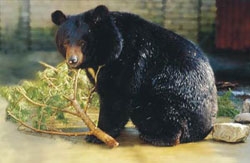
Thirty-five bears have been rescued by a wildlife conservation organisation based in HCM City that protects bears from trafficking and being raised in household cages. The bears are being rehabilitated at the Cat Tien Bear Sanctuary in Dong Nai province.
 |
| A moon bear is rehabilitated at Cat Tien Bear Sanctuary in Dong Nai. The sanctuary aims at protecting bears from being trafficked or raised in household cages. |
Thirty-five bears have been rescued by a wildlife conservation organisation based in HCM City that protects bears from trafficking and being raised in household cages.
The bears are being rehabilitated at the Cat Tien Bear Sanctuary in southern Dong Nai Province, which was set up by the non-profit organisation Wildlife at Risk (WAR).
The bears had been exploited by humans or abused during the trafficking process.
According to Nguyen Van Cuong, manager of the sanctuary, most of the bears were rescued from cages at households that take out the bile form the animals' gallbladders.
"The bears are usually in very bad health due to overexploitation of the gallbladder, and also because of poor feeding as well as bad caretaking," Cuong said.
On an area of 3.5ha of forestland, the rescued bears have received treatment for wounds and disease and have been given nutritious food, health check-ups and training.
"Each bear practices for three to six hours in a spacious area that we named the ‘half-wild zone,' where they can run, climb, sleep on trees, find water to drink or collect dry seeds to eat," Cuong said.
The area covers 1.5ha of the sanctuary's total area under the shade of trees in the Cat Tien National Park.
The activities are carried out in groups of bears that are familiar with each other.
Two bears are kept in a cage that has a water fountain and two steel hammocks on which they can sleep.
Cuong said bears liked to sleep in trees and the hammock was one way to regain their natural instincts after years of being imprisoned in cages by illegal breeders.
In Viet Nam, people started bears raising for gallbladder in 1993, following a trend that began in North Korea and then South Korea and China in the 1980s.
Oriental medicine uses gallbladders to cure many symptoms, including stomach problems, liver cancer, external treatment of bruises and stomachaches.
Wealthy men use gallbladder as an ingredient in a wine mixture that is used for good health.
This trend has contributed to the gallbladder's reputation as a magic medicine among men, which has led to a robust illegal trade.
About 5,000 bears, including moon bears (Ursus Thibetanus) and sun bears (Ursus Malayanus), are being kept by illegal traders in Viet Nam, who put bears in a small cage and take out the gallbladder bile at least four times a year.
Though raising wild bears is illegal, the practice in Viet Nam continues unabated.
Cuong said that most bears that were rescued were in bad health, with opaque eyes, many wounds on their skin, and inflamed abdomens.
"They can't move in the small cages and they were not fed enough. Sanitation was really bad as well," he explained. "People overexploited the gallbladder until they became exhausted." Their abdomen became inflamed because of many contacts with needles used to take out bile from the gallbladder.
Some of the rescued bears in the sanctuary even lost their paws. One folk tale says that bear paws can restore men's sexual health.
Meals from bear paws are nutritious but they do not enhance sexual health, according to experts. Illegal raising of bears usually leaves the bear unhealthy, and after so many years of poor care, the bears' paws are cut off for sale. Thus, the paw is no longer nutritious.
Do Thi Thanh Huyen, WAR's wildlife education manager, said the number of bears rescued from illegal raisers had been increasing and it had become a burden on the WAR budget to fund the sanctuary.
"We try to collect funds every single quarter from donors to help us at the sanctuary," she said.
The initial purpose of the sanctuary, set up in 2002, was to rescue bears from trafficking.
Cuong, who is also the chief veterinarian of the sanctuary, said rescued bears often could not regain their natural instincts.
WAR continues to rescue bears so they will not be killed after exploitation.
There are 63 bears at WAR sanctuaries, including those in Cat Tien and Cu Chi in HCM City and Hon Me in southern Kien Giang Province.
(Source: VNS)



